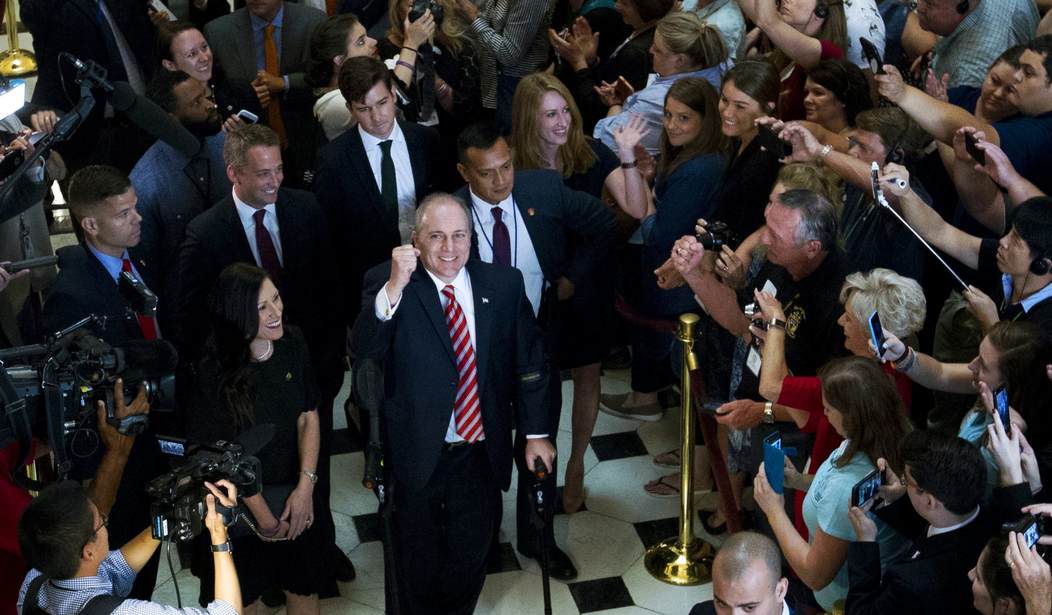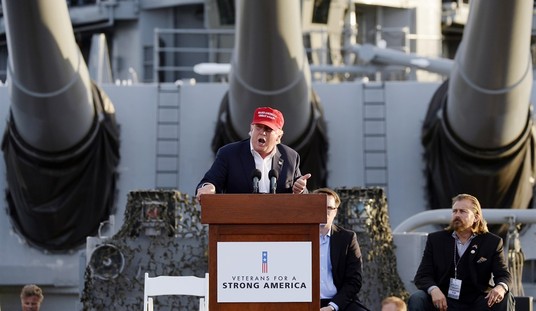June 14, 2017, should have been the worst political massacre in U.S. history. A gunman with armor-piercing ammunition targeted mostly defenseless Republican congressmen and senators. Yet a series of events that can only be described as miracles prevented any man or woman from losing their life that day, with the exception of the shooter himself.
“It’s not just that I felt protected by a higher power, it’s that I really tested that higher power. We made God work overtime to get the pieces in place for me to survive,” writes House Majority Whip Steve Scalise (R-La.) in his forthcoming book “Back in the Game: One Gunman, Countless Heroes, and the Fight for My Life.”
The book is not just inspiring, but a great pleasure to read. Scalise nearly died, but he tells the gripping story with good humor, fascinating side stories, and more than a few laughs at himself. It is truly inspiring to read about the lengths to which so many heroes went to save Scalise’s life, and then help him recover his strength. (One particular story about a historic restaurant in New Orleans is particularly fun.)
The towering figure of God Himself pervades the narrative, however. The number of coincidences necessary to prevent a political massacre and to keep Scalise himself alive is truly mindboggling.
Here are seventeen of those miracles from the book, but Scalise could probably list off many more.
1. A locked gate.
Scalise’s narrative of that harrowing day’s events begins with an odd anecdote. Parks Department staff closed and locked a gate by third base on the baseball field in Alexandria, Virginia. That mundane, seemingly meaningless event prevented the gunman (inspired by Left-wing anger at Republicans) from getting onto the field, which would have given him a position to immediately kill off everyone there.
The miracles began long before the shooting ever took place.
2. Rep. Eric Cantor (R-Va.) loses.
When economics professor Dave Brat unseated Eric Cantor in June 2014, the upset left a vacancy in the Republican leadership of the House of Representatives. Scalise recounts the story of his own unlikely victory in the snap election for House majority whip.
The day after his victory, the House sergeant at arms told Scalise, “Now that you’re going to be whip, we need to talk about your security detail.” At the time, Scalise writes, “it felt a little over the top.”
Three years later, however, Special Agents Crystal Griner and David Bailey — who had almost become part of Scalise’s family — made the key vital difference, protecting “what otherwise would have been a completely defenseless team of congressmen and senators.”
If Scalise had not been at the baseball practice and if he had not been House majority whip, the shooter would have been able to kill a sizable portion of Republicans in Congress.
3. Miracles during the shooting.
The shooting lasted all of six minutes, and Scalise captures each moment in riveting detail. At least three shots missed their targets when they arguably should not have.
The shooter’s first bullet bounced off the fence, missing the head of Rep. Trent Kelly (R-Miss.) by inches. Another bullet hit Tyson Foods lobbyist Matt Mika in the chest — but struck him millimeters away from his heart, allowing him to survive the shooting.
As David Bailey — whom Scalise affectionately calls “Dave” — ran into the fight to protect Scalise from the shooter, a bullet smashed his iPhone, which “probably saved him from a devastating wound like mine.”
Since Dave started shooting back, distracting the shooter near the beginning, this little miracle kept the shooter from turning his attention to the vulnerable congressmen and senators, and from shooting Scalise again.
4. The heroism of David Bailey and Crystal Griner.
During the shooting, “Crystal knew she was exposed and at tremendous risk, but her instinct was similar to Dave’s, that it was okay to be in harm’s way, just as long as she was drawing the danger away from the field, where the players were crouching for cover. She was trained for this, as much as anyone can be trained for something that had never happened before.”
The heroism of these two agents went beyond training, however. “These agents were acting partly because they’re always prepared, but partly just out of pure courage, a kind of courage and heroism I still can’t quite grasp, I still can’t quite understand where it came from,” Scalise writes.
5. Advance notice.
Counties across America have excellent emergency response systems, but news of this shooting traveled even faster than 9-1-1 calls. Scalise recalls how one woman rang the doorbell at a fire station, even as the 9-1-1 call lines were jammed.
“Thanks to concerned citizens, some of the first responders didn’t even have to wait for the 911 system, which meant that crucial moments were shaved off their response time,” the congressman writes.
These few moments were to prove essential for Scalise’s survival.
6. Right place at the right time.
Alexandria police officer Kevin Jobe was on a patrol route at the time of the shooting, and his route took him within a few thousand feet of the baseball field.
At the crucial moment, Jobe arrived on the scene. David Bailey was running out of ammunition, and soon would be unable to carry on the fight. “Jobe, for his part, had no way of knowing just how much ammunition the gunman had and didn’t know that, until that very moment, the man braced over the hood of the Suburban [Bailey] was all that stood between the gunman and the worst political massacre in American history,” Scalise wrote.
“Jobe had no way of knowing that Dave was on his last magazine, about to run out of ammo, or that Crystal, Dave’s only other backup, was down” with a busted ankle. “Jobe had arrived with nearly miraculous speed, and still, he was there at the very last possible moment.”
7. The Bushmaster rifle.
Another Alexandria police officer, Alexander Jensen, was supposed to be getting off his shift that morning — he had been on duty since 8:30 p.m. the night before! As the shooting started, Jensen was monitoring school drop-off less than two miles away. When he got the call, Jensen didn’t hesitate.
“Even though he was just minutes away from going home after his all-night shift, he put the car in gear and turned his lights and sirens on,” Scalise writes. Both Jensen and officer Nicole Battaglia drove toward the scene — right into the gunman’s range.
The shooter shot at Battaglia, giving Jensen the crucial time to take out his Bushmaster rifle. After a few tense moments, that rifle hit the gunman. Jobe shot and Bailey hit the gunman, spinning him around.
Without Jensen’s decision not to go home, the rifle that brought down the gunman would not have gotten to the scene of the shooting.
8. Brad Wenstrup.
Rep. Brad Wenstrup (R-Ohio), served as a Army doctor at Abu Ghraib field hospital. During his tour of duty, he saw many things, but one particular story “stuck with him,” Scalise recalls. One soldier had died of internal bleeding, even though blood was only oozing out of him.
“If they’d known just a little sooner what had happened; if someone out in the field had know that the lack of a big entry wound doesn’t necessarily mean a lack of major hemorrhaging; if someone had gotten him to the hospital just a little quicker; if someone just a little earlier had said, ‘Hey, we need to check for internal bleeding,'” then maybe that soldier would have lived.
“In a very real way, that young soldier’s death saved my life,” Scalise writes.
The book tells the story of Wenstrup’s path to Congress — a wonderful tale full of unlikely coincidences. On June 14, 2017, however, Wenstrup’s schedule cleared up, so he stayed at the baseball field longer than usual.
Wenstrup rushed to Scalise as soon as the shooter was down, and applied what the whip describes as “the best, tightest, most secure tourniquet ever applied.”
9. Every traffic light — green.
When paramedic and fireman Richard Krimmer took off in his ambulance, speeding to the scene of the shooting, he expected the trip to take twice as long as it did.
“It was right around that time that Krimmer noticed how strangely clear the roads were. It should have been bumper to bumper. For some reason, the route between the station and the field was empty. It seemed abandoned,” the book tells. “Somehow, every single traffic light turned green just as they were approaching. They hit only green the whole way.”
10. A perfect hand-off.
Krimmer was uniquely suited to take care of Scalise that day. He took an unusual interest in medicine, even for a paramedic. That enabled him to understand why Wenstrup was so adamant that the whip’s life was in danger, even though there wasn’t much blood.
“In this case, were was a dissonance — a doctor expressing so much concern about bleeding when there was no apparent bleeding— that loosened from the recesses of Krimmer’s mind a fact that he knew and had, actually, always been intrigued by. A curiosity of the human body he’d heard about in an anatomy class or textbook once and that had stuck with him — that you can bleed half of your blood volume into your pelvis. Which means that you can bleed to death without anyone seeing a drop of blood,” the book explains.
“Krimmer was uniquely suited to register the counterintuitive notion that I was bleeding into my body,” Scalise adds. “I was handed over from a doctor who’d seen an almost identical would to a paramedic with an almost obsessive level of interest in human anatomy, so the non obvious fact that my life was in imminent danger survived the transfer.”
11. Park Police chopper.
Krimmer called for a helicopter, but it came much faster than it should have. As soon as Crystal Griner had reported that congressmen had come under fire, the Park Police dispatched themselves. The Washington, D.C. airspace is the most secure airspace in the country, but since the Park Police enforce that security, their helicopters can travel across the city the fastest.
The helicopter staff did not know, however, that it was Scalise whose life was in danger. They chopper arrived and picked up Griner, whose ankle had been shattered by a bullet but whose life was not in danger.
Scalise Responds to Attacks on Susan Collins: Dems Must Condemn ‘Violence and Threats From the Left’
12. Extremely fast helicopter.
This critical mix-up could have cost the whip his life, but another small miracle gave the chopper pilot an extra set of wings.
“The chopper dropped Griner off a little before 8:00 AM. It dropped me off a little after 8:00 AM. Even in retrospect, it still doesn’t actually seem possible,” Scalise writes. “In that time, just a few minutes, the pilot flew from northwest Washington, D.C., down past the Washington Mall, pas the Washington Monument, past the Pentagon and Reagan National Airport, to the park in Alexandria, and then did that trip in reverse.”
The whip quotes the pilot, who said, “I flew that bird like I stole it.”
13. Moment of overlap.
When the whip arrived at MedStar Washington Hospital Center, there were two trauma teams mobilized and waiting for him.
“Every morning, just after the doctors and nurses arrive, and just before the overnight team leaves, there’s a short period of time during which they all overlap,” the book explains. “The call from the chopper came in at exactly that moment of overlap. Not only was the team already in position, near the trauma bay — there were also twice as many people ready to respond.”
The double-teaming proved vital. “I was going into a death spiral, a cycle of functions shutting down, each critical system failure compounding another,” Scalise recalls.
14. Massive Transfusion Protocol.
Brad Wenstrup’s experience was not the only time the death of soldiers helped to save Sacalise’s life. The whip had lost so much blood, he needed the equivalent of three people pumped into him.
This was possible thanks to the Massive Transfusion Protocol (MTP), a system “perfected in combat hospitals by forward deployed doctors like Brad.”
“Where soldiers have died, other people have benefitted. Countless soldiers injured or killed serving for this country, and every doctor and nurse who treated them, have helped give trauma patients extra time.”
15. Susan Kennedy.
Trauma nurse Susan Kennedy took care of the whip when he landed off the helicopter. A heroine who had rushed to the Pentagon to save people on September 11, 2001, Kennedy was no stranger to tense situations. Shortly after Scalise arrived, police and a security detail showed up to keep him safe, thinking the danger had not yet passed.
Kennedy took charge, setting a limit on how many guards could be there, and moving the patient around to figure out just how badly he was wounded.
16. Jack Sava.
Surgery director Dr. Jack Sava remembers the first time he saw someone die. He was in medical school, and what really stood out to him was the calm of the doctor who took care of the dying woman. This event inspired him to study how to deal with stress. His co-workers mocked him for this obsession, but it may have saved Steve Scalise’s life.
“His team became a live-action sociology experiment, in which no proposal for addressing the boxing gloves of fear was too outlandish,” Scalise writes. “It becomes very easy to make the justified, well-reasoned, and even polite, but wrong assumption that someone else is handling a critical task. As a result, that task never gets done. … Sava makes sure the most junior person around the table is made to feel he is an intelligent being, whose observations are welcomed, even by the most senior, busy surgeon there.”
This training was key, because “with my condition so dire, even just one mistake would probably mean the difference between life and death.”
17. Your prayers.
Toward the end of the book, the House Majority Whip explains why he wrote it.
“This book has been my way of trying to continue what I started from the lectern” on that day in the House of Representatives, where Scalise thanked all the people who helped him survive, recover, and speak again from the Capitol.
“This book has been me trying to show you how many miracles had to happen for me to have this second chance and how many people played parts in those miracles. It’s me trying to explain just how much those prayers mattered, how powerfully I felt them,” Scalise writes. He says he owes his life not just to the people who directly helped him, but to those who prayed for him and encouraged God to “work overtime” to save him.
If you prayed for Scalise during or after the shooting, you may indeed be one more of the miracles that kept him alive and prevented a national tragedy from becoming so much worse.
I highly encourage Americans to read Scalise’s book (which can be purchased here). In a time of increasing political incivility, it is inspiring to hear how so many Americans responded to the tragedy with love and support. Their names, more than that of the shooter, deserve to be remembered.
As a nation, Americans should put politics in its proper place, keeping family, community, God, and service first. The shooter who nearly killed Steve Scalise made politics into a religion, just like the “MAGA bomber.” No matter what happens, political struggles are not the end of the world, and the heart of America is better expressed by those who prayed for and helped Steve Scalise than by the wicked man who aimed to kill him.
As Scalise wrote, “here, in this country, with these people, that bullet never had a chance.”
Follow the author of this article on Twitter at @Tyler2ONeil.









Join the conversation as a VIP Member